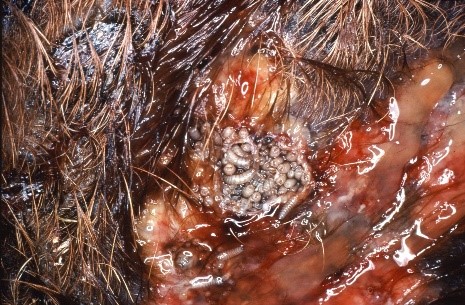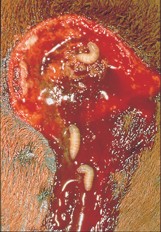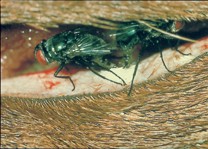Chrysomya bezziana
What to look for
Check any animals, birds or humans for wounds and for signs of maggots deep within the wound. Wounds that can become infested include husbandry wounds (for example ear-tagging, castration and dehorning) and relatively minor skin wounds (such as tick bites). Maggots can also be found in moist body areas, including the umbilicus, eyes, vulva and mouth.

Screw worm fly maggots in a wound example 1

Screw worm fly maggots in a wound example 2

A screw worm fly laying its eggs in an open wound
What you can do
- Do not move live animals or untanned hides or skins out of the Torres Strait Protected Zone to the Torres Strait Permanent Biosecurity Monitoring Zone, or from either zone to mainland Australia without a permit and an inspection by a departmental biosecurity officer.
- Report any signs of wounds with maggots in animals, birds or humans to the Emergency Animal Disease Hotline on 1800 675 888.

Live animals and untreated hides or skins need a permit to move south between zones and to mainland Australia.
Profile
Screw worm fly is an insect parasite of warm-blooded animals (including people and birds). Flies can lay eggs in many types of wounds and moist areas on animals or people. Wounds can include small scratches, branding marks or castration wounds , and one injury can be struck many times. Once the eggs hatch the maggots feed on the flesh of their host. Unlike other flies whose maggots can be found in dead animals, screw worm fly maggots only feed on tissue in live animals. The flies can multiply quickly – maggots can hatch from eggs within 24 hours in warm, tropical climates like that of northern Australia. The maggots can cause debilitating tissue damage, leading to significant production losses and possibly even death.
Identification
Old World screw worm fly looks just like an Australian blowfly with a shiny blue-green body and a yellow face. Maggots may be hard to see, as they often burrow deep in the wound. A fly-struck wound will often weep and emit a pungent, rotten smell.
Distribution
Old World screw worm fly is found in parts of Africa, the Middle East, Asia and the Pacific, including the areas of Papua New Guinea that border Torres Strait . A similar fly has been eradicated in the United States at great cost, but it is still found in many countries south of Mexico. Both flies would have the same impact if they became established in Australia. However, the Old World screw worm fly is considered a greater risk due to its close proximity to Australia.
Threat
Animals infested with screw worm fly may eventually die from loss of tissue, fluid and infection. If the screw worm fly were to establish in Australia it would have disastrous effects on our livestock industry (particularly cattle and sheep), but could also threaten our native wildlife and human health. It could cost our livestock industries millions of dollars a year in lost production and control measures.
Keep a Top Watch!
Report incidents of animals being transported illegally to Australia from neighbouring countries. Check wounds on all live animals for maggots – even small wounds. If you find maggots, collect some and place them into just-boiled water, then preserve them in three parts methylated spirits to one part water. Note the location, take photos if you can , and send to NAQS immediately .
The department distributes screw worm fly collection kits to pastoralists, health clinics, ranger groups and vets throughout northern Australia so that maggots from struck animals can be submitted for identification. For a free kit or for further advice contact NAQS .
Secure maggots found in live animals and send to NAQS for identification.
